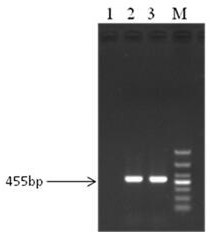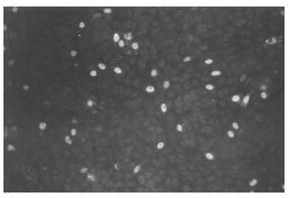A kind of isolation method of porcine parvovirus
A parvovirus and separation method technology, applied in the direction of virus, virus/bacteriophage, single-stranded DNA virus, etc., can solve the problems of unfavorable timely diagnosis of porcine parvovirus disease, cumbersome virus sample processing process, and low virus purity, etc. Timely diagnosis and research, shortened separation cycle, simple and fast preparation
- Summary
- Abstract
- Description
- Claims
- Application Information
AI Technical Summary
Problems solved by technology
Method used
Image
Examples
Embodiment 1
[0025] Example 1: Preparation of CEF primary cells
[0026] Take 9-10-day-old SPF chicken embryos with rich blood vessels and vigorous vitality. After disinfection, use large-head tweezers to gently break the air chamber of the chicken embryo body to expose the embryo body. After carefully picking out the embryo body, place it in a pH 7.0 PBS solution containing berberine (each 1000ml contains 6-10 g sodium chloride, 0.05-0.5 g potassium chloride, 1-1.2 g disodium hydrogen phosphate, 0.05-0.5 g potassium dihydrogen phosphate, 0.05-0.05 g calcium chloride 0.2 g, magnesium chloride containing 6 crystal water 0.05-0.2 g, berberine 1-3 mg; mix the above ingredients, dissolve in 1000 ml double distilled water, filter through a 0.22 um filter membrane, and place in Store at 4°C for later use; or sodium chloride 6-10 g, potassium chloride 0.05-0.5 g, disodium hydrogen phosphate 1-1.2 g, potassium dihydrogen phosphate 0.05-0.5 g, calcium chloride 0.05-0.2 g, containing 6 Magnesium ch...
Embodiment 2
[0027] Example 2 Collection and processing of disease materials
[0028] Aseptically collect the heart, liver, spleen, lung, and kidney of the stillborn and mummified fetuses of breeding sows, place them in a meat grinder and grind them, add D-Hanks solution twice the total mass of the minced meat to the minced meat, and grind through colloid Grind well and mix well. The obtained mixed solution is placed in a high-pressure homogenizer, and the temperature is controlled below 25° C. during the homogenization process to obtain a homogenization treatment solution. Add D-Hanks solution to the homogenate treatment solution at a ratio of 1:1, 1:2 or 1:3 (each 1000 ml consists of the following ingredients: 8-10g of sodium chloride, 0.4-0.6g of potassium chloride, containing 1 Disodium hydrogen phosphate 0.04-0.08g, Potassium dihydrogen phosphate 0.04-0.06g, Sodium bicarbonate 0.3-0.5g, Phenol red 0.01-0.02g; Mix the above ingredients thoroughly, dissolve in 1000ml double distilled w...
Embodiment 3
[0029]Example 3: Cell inoculation of virus
[0030] The primary CEF cells that have been cultured for 24 hours and grew well, the cell culture medium was discarded, and the virus stock solution and cell culture medium were added at a ratio of 1:8, 1:9 or 1:10 (V:V), and a positive control of PPV was set at the same time and the blank control group, and then placed at 37°C, 5% CO 2 Incubate in the incubator for 1 hour, discard the virus solution, add virus maintenance solution containing 2% fetal bovine serum, continue to cultivate for 90 hours, observe cell changes every day, negative and positive control groups are established, collect the cell solution with obvious changes, and place in - Store at 20°C.
PUM
 Login to View More
Login to View More Abstract
Description
Claims
Application Information
 Login to View More
Login to View More - R&D
- Intellectual Property
- Life Sciences
- Materials
- Tech Scout
- Unparalleled Data Quality
- Higher Quality Content
- 60% Fewer Hallucinations
Browse by: Latest US Patents, China's latest patents, Technical Efficacy Thesaurus, Application Domain, Technology Topic, Popular Technical Reports.
© 2025 PatSnap. All rights reserved.Legal|Privacy policy|Modern Slavery Act Transparency Statement|Sitemap|About US| Contact US: help@patsnap.com



